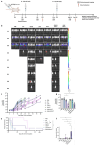This is a preprint.
Precision Enhancement of CAR-NK Cells through Non-Viral Engineering and Highly Multiplexed Base Editing
- PMID: 38496503
- PMCID: PMC10942345
- DOI: 10.1101/2024.03.05.582637
Precision Enhancement of CAR-NK Cells through Non-Viral Engineering and Highly Multiplexed Base Editing
Update in
-
Precision enhancement of CAR-NK cells through non-viral engineering and highly multiplexed base editing.J Immunother Cancer. 2025 May 7;13(5):e009560. doi: 10.1136/jitc-2024-009560. J Immunother Cancer. 2025. PMID: 40341025 Free PMC article.
Abstract
Natural killer (NK) cells' unique ability to kill transformed cells expressing stress ligands or lacking major histocompatibility complexes (MHC) has prompted their development for immunotherapy. However, NK cells have demonstrated only moderate responses against cancer in clinical trials and likely require advanced genome engineering to reach their full potential as a cancer therapeutic. Multiplex genome editing with CRISPR/Cas9 base editors (BE) has been used to enhance T cell function and has already entered clinical trials but has not been reported in human NK cells. Here, we report the first application of BE in primary NK cells to achieve both loss-of-function and gain-of-function mutations. We observed highly efficient single and multiplex base editing, resulting in significantly enhanced NK cell function. Next, we combined multiplex BE with non-viral TcBuster transposon-based integration to generate IL-15 armored CD19 CAR-NK cells with significantly improved functionality in a highly suppressive model of Burkitt's lymphoma both in vitro and in vivo. The use of concomitant non-viral transposon engineering with multiplex base editing thus represents a highly versatile and efficient platform to generate CAR-NK products for cell-based immunotherapy and affords the flexibility to tailor multiple gene edits to maximize the effectiveness of the therapy for the cancer type being treated.
Conflict of interest statement
Conflict of interest statement M.W., E.J.P., M.G.K., B.S.M. and B.R.W. have filed patents covering the methods and approaches outlined in this work.
Figures






Similar articles
-
Precision enhancement of CAR-NK cells through non-viral engineering and highly multiplexed base editing.J Immunother Cancer. 2025 May 7;13(5):e009560. doi: 10.1136/jitc-2024-009560. J Immunother Cancer. 2025. PMID: 40341025 Free PMC article.
-
Concurrent transposon engineering and CRISPR/Cas9 genome editing of primary CLL-1 chimeric antigen receptor-natural killer cells.Cytotherapy. 2022 Nov;24(11):1087-1094. doi: 10.1016/j.jcyt.2022.07.008. Epub 2022 Aug 29. Cytotherapy. 2022. PMID: 36050244
-
Revolutionising Cancer Immunotherapy: Advancements and Prospects in Non-Viral CAR-NK Cell Engineering.Cell Prolif. 2025 Apr;58(4):e13791. doi: 10.1111/cpr.13791. Epub 2024 Dec 27. Cell Prolif. 2025. PMID: 39731215 Free PMC article. Review.
-
Engineering the next generation of CAR-NK immunotherapies.Int J Hematol. 2021 Nov;114(5):554-571. doi: 10.1007/s12185-021-03209-4. Epub 2021 Aug 28. Int J Hematol. 2021. PMID: 34453686 Free PMC article. Review.
-
Enhanced NK-92 Cytotoxicity by CRISPR Genome Engineering Using Cas9 Ribonucleoproteins.Front Immunol. 2020 May 22;11:1008. doi: 10.3389/fimmu.2020.01008. eCollection 2020. Front Immunol. 2020. PMID: 32528479 Free PMC article.
References
-
- Ruggeri L. et al. Effectiveness of donor natural killer cell alloreactivity in mismatched hematopoietic transplants. Science 295, 2097–2100 (2002). - PubMed
-
- Miller J. S. & Lanier L. L. Natural Killer Cells in Cancer Immunotherapy. Annu. Rev. Cancer Biol. 3, 77–103 (2019).
Publication types
Grants and funding
LinkOut - more resources
Full Text Sources
Research Materials
